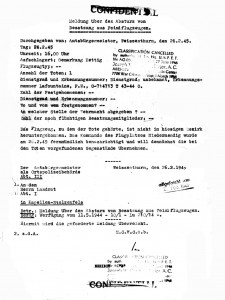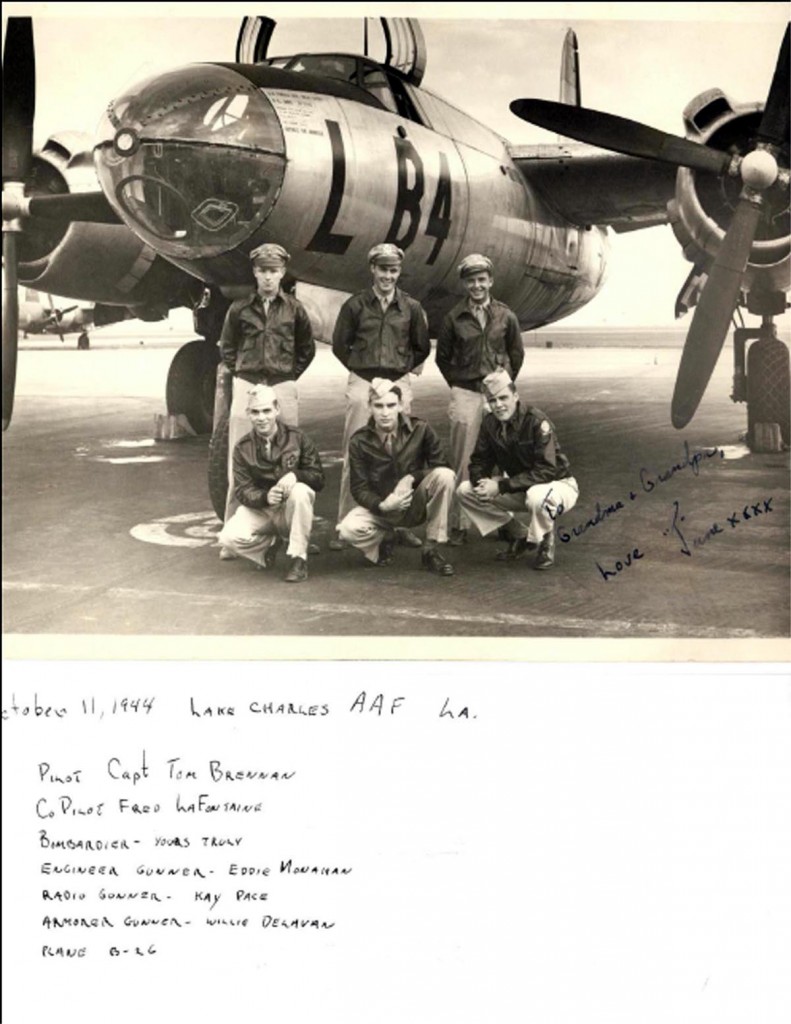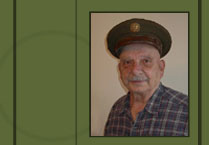Summary: Third and Final Crew of the Shopworn Angel
344th Bomb Group (Adapted from the research of J. Kurt Spence)
The 344th Bomb Group of the Ninth Air Force was a medium bomber unit that took part in the tactical bombing of the European Theater. The 495th Bomb Squadron, was also known as the Silver Streaks because of the distinctive aircraft markings. Originally stationed at Stanstead, England, the unit moved to Station A-59 Cormeilles-en Vexin, France on 30 September 1944. Cormeilles-en Vexin is located about 40 kilometers northwest of Paris. As the Allies advanced, the unit moved again on 5 April 1945 to Station A-78 Florennes, Belgium. During early 1945 the missions for the bomb groups were German rail marshaling yards and V-1 rocket launch sites in France.
Captain Thomas G. Brennan and his five crew members were training as a replacement crew at Lake Charles, LA when this photo was taken on 11 October 1944.
Standing left to right: Pilot – Capt. Tom Brennan; Co-pilot – Fred LaFountaine, Jr.; Bombardier – Harry Zuest. Knelling l to r: Engineer gunner – Eddie Monahan; Radio gunner – Roy Pace; Armorer gunner – Willard Delavan.
Brennan piloted the third crew to fly the B-26B 50, serial number 42-95917, nicknamed “Shopworn Angel.” They were assigned to the 495th Bomb Squadron and their code was N3. They were the last crew of “Shopworn Angel”.
“Shopworn Angel” had previously suffered a belly landing by another crew headed by Captain Clay, as shown above.
.
The photo below was taken on 12 February 1945. It shows tail gunner Tech. Sgt. Vander Lugt just before flying their mission. He was killed on that mission. Just two days later, Shopworn Angel flew it’s last mission and was shot down.
Photograph provided by Donald Moomaw
.
The 344th Bomb Group was tasked with a bombing mission on Valentine’s Day 14 February 1945. The target that day was the railroad bridge crossing over the Rhine River at Engers, Germany. Five aircraft were shot down that day and a total of 31 airmen were listed as either missing or killed in action.
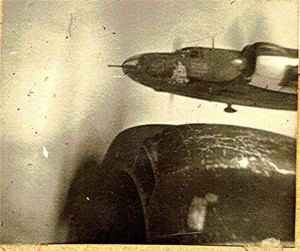
Undated photograph of Shopworn Angel
.
Captain Thomas Gough Brennan, Jr. (O-793050) was the pilot for the six man crew of the B-26 Martin. At approximately 1632 hours and just minutes before reaching the target, “Shopworn Angel” and the crew suffered a direct hit from German flak. The aircraft was at 11,000 feet when anti-aircraft flak hit the plane and caused a fire to break out in the bomb bay. Several gunners were wounded and Capt. Brennan shouted “Bail Out!” to the crew. Co-pilot Frederick LaFontaine, Jr. and bombardier Harry W. Zuest bailed out. Eyewitnesses saw two parachutes drift away as the aircraft went into a spin, making a left turn off the target.
The following eyewitness account was given by Sgt. John E. Callahan, of the 496th Bomb Squad, in a written statement four days after the crash.
“I saw the plane above and to the right in a one o’clock position apparently in the first box, position three of flight one (piloted by Cpt. Brennan) hit by enemy flak directly over the target. I did not see any bombs released by this plane before being hit. Brown smoke like burning oil trailed out of the left nacelles. Plane immediately made a left turn off the target. Plane was lost from sight for a moment. I picked up sight of the plane again on the turn off of the target as the plane was flying in the same direction. Thirty (30) seconds later the plane went into a dive. I called to the bombardier who could see the plane from his position. The bombardier said he saw the plane go into a spin and observed it until lost from view about 1500 feet from the ground. I saw two chutes drifting back towards the target.”
Eyewitness Lt. Donald Moomaw, another B-26 pilot from the 495th BS flying the right lead that day gave the following account several years later:
“This is to best of my memory; the target, Engers RR Bridge, a very well protected target, and lots, lots, lots of heavy flak. This mission we did not go on the bomb run in the regular formation, we went trail formation (see diagram), all the flight lined up, one back of the other, the flights back of the lead were 500 ft below the flight ahead. I was #2, right
wingman of the lead plane, Piloted by Major Clay . . . Shopworn Angel #3, was the left wingman.
A glancing vision, I saw the right engine on fire, the co-pilot half out of seat, facing the pilot, and I am sure he was saying we are on fire, and generally the fire spreads, Shopworn Angel pulled out of formation to left, no idea of what happened after that.”
Pilot Brennan was able to gain control of the aircraft and crash landed in farm fields 1½ kilometers southwest of Kruft, Germany. LaFontaine and Zuest were captured by civilians and hung to death. Buried in a local community cemetery, the bodies were later interred in the Margraten Cemetery in Holland. Sgt. Edward J. Monahan, the engineer, was killed in the crash. The remaining crew of three were slightly wounded and attempted to evade capture. However, Brennan was captured, put into the back of a truck with a noose around his neck. The aging truck was coal fired because of lack of gasoline and would not start. A Luftwaffe officer happened along and saved Brennan’s life from the angry mob. He later was taken as a prisoner-of-war.
.
Sgt. Willard Alexander Delavan managed to evade capture until the afternoon of the next day. He was finally caught at about 1600 hours in the neighboring village of Ochendung, Germany. Missing Air Crew Report 12344 was filed when the aircraft failed to return to base. The Luftwaffe produced a casualty report number KU 3687.
.
Captain Thomas Gough Brennan, Jr. (O-793050) was the pilot. He was born on 5 May 1920 in New York City the son of Major Thomas Gough Brennan (1889-1971) and Mary Lee (Schwartz) Brennan. Brennan’s father was also in the U.S. Army serving during World War I and later served as military governor of a town in Sicily. Brennan was captured and served as a prisoner-of-war.
2nd Lt. Frederick William LaFountaine, Jr. (O-714713) was the co-pilot. He was born in 1924 in Pawtucket, RI the son of Frederick William LaFountaine (1898-1980) and Margaret L. LaFountaine (1899-1980). After being hanged by the locals, LaFountaine was initially buried in a local cemetery and later buried in the Luxembourg American Cemetery in Hamm, Luxembourg. He was posthumously awarded the Purple Heart and Air Medal.
.
2nd Lt. Harry William Zuest (O-2068152) was the bombardier. Zuest was born in 1925 in Elizabeth, New Jersey the son of Harry L. Zuest (1898-1966) and Dorothy M. (Fenderson) Zuest (1904-?). By the time he was 15, the family was living in Union, NJ. Six weeks before he was to graduate high school and not wanting to be drafted, young Zuest enlisted in the U.S. Army Air Corps in 1943. He was sent to training at Jefferson Barracks, MO and Texas and later
attended Knox College in Illinois. He was sent to bombardier school and graduated in August 1944. Following a week of leave he returned to be assigned to a crew. After a short 12 hour visit with his family, Zuest shipped out to England with his crew in November 1944. Zuest and his buddies can be seen in the photograph at right, provided by his sister Dorothy J. (Zuest) DiNunzio.
After being hanged by the locals, Zuest was buried in a local cemetery and later buried in the Netherlands American Cemetery in Margratan, Netherlands. He was posthumously awarded the Purple Heart and the Air Medal.
.
Sgt. Koy Fred Pace (38519975) was the radio operator. He was born on 1 May 1925 the son of James Oliver Pace (1878-1952) and Mosie (Robinson) Pace (1884-1978). He enlisted on 21 August 1943. He was taken a prisoner-of-war. After being liberated, Pace was discharged from the Army on 2 November 1945. He married Juanita Mallory (1925-2010) and they lived in Logansport, LA. Pace was president of the Louisiana School Board Association in the late 1960s and also a member of Mount Vernon Lodge #83 of the Free and Accepted Masons in Logansport.
Pace died on 20 January 1981 in Logansport, LA and was buried in the Brookland Cemetery, Shelby County, TX.
.
Sgt. Edward Joseph Monahan (12144326) was the engineer/gunner. He was born in 1924 in Brooklyn, NY the son of Edward Monahan (1899-1950) and Rose Monahan (1898-1999). When he was a young man he worked at the A. Schroder’s & Son store on Vanderbilt Ave. and later Sperry Gyroscope at the Bush Terminal. On 21 September 1942, Monahan enlisted in the U.S. Army Air Corps. After being killed-in-action, Monahan was buried in the Netherlands American Cemetery in Margratan, Netherlands. He was posthumously awarded the Purple Heart.
.
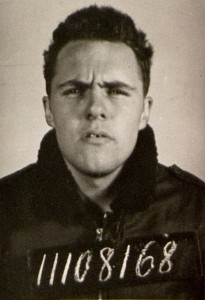 Sgt. Willard Alexander Delavan (11108168) was the tail gunner. He was born on 13 October 1925 in Pittsfield, MA son of Willard A. Delavan (1893-ca.1940) and Hazel M. (Hunt) Delavan Gardner (1889-?). He attended public schools in Pittsfield and after just 2½ years of high school he was admitted to the University of Pennsylvania in January 1943. During high school he was a paper boy for the Berkshire Evening Eagle in Pittsfield. After enlisting in the U.S. Army Air Corps in 1943, he completed armament school training at Fort Lowry, CO and was awarded aerial gunners wings at Fort Myers, FL. He was then assigned to a B-26 bomber crew of the 344th Bomb Group. Delavan was captured and served as prisoner-of-war. Just days after his capture, the photo at right was taken at the German interrogation center at Dulag-Luft – Oberursel. After about a week in a small cell, he and others were sent by box car to Stalag 13A – Nürnberg for a short stay. Delavan and 1,875 other prisoners were forced to march by foot for over 100 miles in the winter to Stalag 7A – Moosburg, arriving in early April. This crowded camp held over 75,000 POWs. After a couple of miserable weeks, he was liberated on 29 April 1945 by elements of the Fourteenth Armored Division, part of General George S. Patton’s Third Army.
Sgt. Willard Alexander Delavan (11108168) was the tail gunner. He was born on 13 October 1925 in Pittsfield, MA son of Willard A. Delavan (1893-ca.1940) and Hazel M. (Hunt) Delavan Gardner (1889-?). He attended public schools in Pittsfield and after just 2½ years of high school he was admitted to the University of Pennsylvania in January 1943. During high school he was a paper boy for the Berkshire Evening Eagle in Pittsfield. After enlisting in the U.S. Army Air Corps in 1943, he completed armament school training at Fort Lowry, CO and was awarded aerial gunners wings at Fort Myers, FL. He was then assigned to a B-26 bomber crew of the 344th Bomb Group. Delavan was captured and served as prisoner-of-war. Just days after his capture, the photo at right was taken at the German interrogation center at Dulag-Luft – Oberursel. After about a week in a small cell, he and others were sent by box car to Stalag 13A – Nürnberg for a short stay. Delavan and 1,875 other prisoners were forced to march by foot for over 100 miles in the winter to Stalag 7A – Moosburg, arriving in early April. This crowded camp held over 75,000 POWs. After a couple of miserable weeks, he was liberated on 29 April 1945 by elements of the Fourteenth Armored Division, part of General George S. Patton’s Third Army.
For his distinguished service as a gunner, Delavan was awarded the Air Medal and the Purple Heart. He returned to the University of Pennsylvania after his honorable discharge in 1945. He earned a bachelor’s degree and then a doctorate degree in dentistry from Penn. In 1949, Delavan was employed with the research division of Smith, Kline and French Laboratories in Philadelphia. He was engaged to be married to Lois Reilly but the marriage was broken off.
Delavan later married Mary Elizabeth Riordan on 14 January 1952 in Greenwich, CT. After that marriage ended, Willard married Ann Christie Koerner of Darien in 1960. they had two children named Willard Alexander Delavan and Thomas Edward Delavan. The former became an economics professor, the later is a designer and a writer for the New York Times. Delavan practiced dentistry for 20 years in Darien, CT; in Champlain, NY in the late 1970’s and in Williamstown, Ma. from 1981-1984. In retirement, he was very active. He loved golf, played softball until the age of 65 and won a Super G race at the age of 69 years. He moved to Leadville, CO in 1987 and worked at Ski Cooper for 11 years.
Delavan died on 23 December 1997 in Colorado and was buried in Cheshire Cemetery in State College, PA.
.
In early 2014, German researcher Richard Schneck, who lives in Rhens just 14 miles south-east of the crash site, provided the following document relating to the crash. The letter, from the county administration, reported the crash occurred in the Kettig area about 4 miles east of Kruft, that one airman was killed, F.W. Lafountaine, and no POWs were taken. He is conducting more research on the crash. 